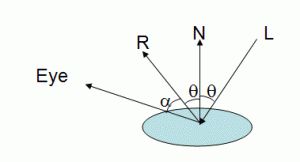GLSL 逐顶点的光照
在OpenGL中有三种类型的光:方向光(directional)、点光(point)、聚光(spotlight)。本教程将从方向光讲起,首先我们将使用GLSL来模仿OpenGL中的光。
我们将向shader中逐渐添加环境光、散射光和高光效果。
后面的教程中我们将使用逐像素光照以获得更好的效果。
接下来我们将实现逐像素的点光和聚光。这些内容与方向光很相近,大部分代码都是通用的。
在卡通着色的教程中我们接触过在GLSL中如何访问OpenGL状态中关于光源的部分,这些数据描述了每个光源的参数。
struct gl_LightSourceParameters
{
vec4 ambient;
vec4 diffuse;
vec4 specular;
vec4 position;
vec4 halfVector;
vec3 spotDirection;
float spotExponent;
float spotCutoff; // (range: [0.0,90.0], 180.0)
float spotCosCutoff; // (range: [1.0,0.0],-1.0)
float constantAttenuation;
float linearAttenuation;
float quadraticAttenuation;
};
uniform gl_LightSourceParameters gl_LightSource[gl_MaxLights];
struct gl_LightModelParameters
{
vec4 ambient;
};
uniform gl_LightModelParameters gl_LightModel;
在GLSL中也同样可以访问材质参数:
struct gl_MaterialParameters
{
vec4 emission;
vec4 ambient;
vec4 diffuse;
vec4 specular;
float shininess;
};
uniform gl_MaterialParameters gl_FrontMaterial;
uniform gl_MaterialParameters gl_BackMaterial;
在OpenGL程序中,这些参数中的大部分,不论属于光源还是材质,用起来都是相似的。我们将使用这些参数实现自己的方向光。
方向光I
本节的公式来自《OpenGL编程指南》中“和光照有关的数学知识”这一章。
我们从散射光开始讨论。在OpenGL中假定,不管观察者的角度如何,得到的散射光强度总是相同的。散射光的强度与光源中散射光成分以及材质中散射光反射系数相关,此外也和入射光角度与物体表面法线的夹角相关。
OpenGL用下面的公式计算散射光成分:
I是反射光的强度,Ld是光源的散射成分(gl_LightSource[0].diffuse),Md是材质的散射系数(gl_FrontMaterial.diffuse)。
这个公式就是Lambert漫反射模型。Lambert余弦定律描述了平面散射光的亮度,正比于平面法线与入射光线夹角的余弦,这一理论提出已经超过200年了。
在顶点shader中要实现这个公式,需要用到光源参数中的方向、散射成分强度,还要用到材质中的散射成分值。因此使用此shader时,在OpenGL中需要像在平时一样设置好光源。注意:由于没有使用固定功能流水线,所以不需要对光源调用glEnable。
要计算余弦值,首先要确保光线方向向量(gl_LightSource[0].position)与法线向量都是归一化的,然后就可以使用点积得到余弦值。注意:对方向光,OpenGL中保存的方向是从顶点指向光源,与上面图中画的相反。
OpenGL将光源的方向保存在视点空间坐标系内,因此我们需要把法线也变换到视点空间。完成这个变换可以用预先定义的一致变量gl_NormalMatrix。这个矩阵是模型视图变换矩阵的左上3×3子矩阵的逆矩阵的转置。
以下就是上述内容的顶点shader代码:
void main()
{
vec3 normal, lightDir;
vec4 diffuse;
float NdotL;
/* first transform the normal into eye space and normalize the result */
normal = normalize(gl_NormalMatrix * gl_Normal);
/* now normalize the light's direction. Note that according to the
OpenGL specification, the light is stored in eye space. Also since
we're talking about a directional light, the position field is actually
direction */
lightDir = normalize(vec3(gl_LightSource[0].position));
/* compute the cos of the angle between the normal and lights direction.
The light is directional so the direction is constant for every vertex.
Since these two are normalized the cosine is the dot product. We also
need to clamp the result to the [0,1] range. */
NdotL = max(dot(normal, lightDir), 0.0);
/* Compute the diffuse term */
diffuse = gl_FrontMaterial.diffuse * gl_LightSource[0].diffuse;
gl_FrontColor = NdotL * diffuse;
gl_Position = ftransform();
}
在片断shader中要做的就是使用易变变量gl_Color设置颜色。
void main()
{
gl_FragColor = gl_Color;
}
下图显示了应用此shader的茶壶效果。注意茶壶的底部非常黑,这是因为还没有使用环境光的缘故。
加入环境光非常容易,只需要使用一个全局的环境光参数以及光源的环境光参数即可,公式如下所示:
前面的顶点shader中需要加入几条语句完成环境光的计算:
void main()
{
vec3 normal, lightDir;
vec4 diffuse, ambient, globalAmbient;
float NdotL;
normal = normalize(gl_NormalMatrix * gl_Normal);
lightDir = normalize(vec3(gl_LightSource[0].position));
NdotL = max(dot(normal, lightDir), 0.0);
diffuse = gl_FrontMaterial.diffuse * gl_LightSource[0].diffuse;
/* Compute the ambient and globalAmbient terms */
ambient = gl_FrontMaterial.ambient * gl_LightSource[0].ambient;
globalAmbient = gl_FrontMaterial.ambient * gl_LightModel.ambient;
gl_FrontColor = NdotL * diffuse + globalAmbient + ambient;
gl_Position = ftransform();
}
下图显示了最终效果。加入环境光后整个画面都变亮了,不过相对于应用了反射光效果的全局光照模型(global illumination model),这种计算环境光的方式只能算廉价的解决方案。
方向光II
下面介绍OpenGL方向光中的镜面反射部分。我们使用称为Blin-Phong模型的光照模型,这是Phong模型的简化版。在这之前,我们有必要先看看Phong模型,以便于更好地理解Blin-Phong模型。
在Phong模型中,镜面反射成分和反射光线与视线夹角的余弦相关,如下图:
L表示入射光,N表示法线,Eye表示从顶点指向观察点的视线,R是L经镜面反射后的结果,镜面反射成分与α角的余弦相关。
如果视线正好和反射光重合,我们将接收到最大的反射强度。当视线与反射光相分离时,反射强度将随之下降,下降速率可以由一个称为shininess的因子控制,shininess的值越大,下降速率越快。也就是说,shininess越大的话,镜面反射产生的亮点就越小。在OpenGL中这个值的范围是0到128。
式中指数s就是shininess因子,Ls是光源中镜面反射强度,Ms是材质中的镜面反射系数。
Blinn提出了一种简化的模型,也就是Blinn-Phong模型。它基于半向量(half-vector),也就是方向处在观察向量以及光线向量之间的一个向量:
![]()
现在可以利用半向量和法线之间夹角的余弦来计算镜面反射成分。OpenGL所使用的Blinn-Phong模型计算镜面反射的公式如下:
这个方法与显卡的固定流水线中使用的方法相同。因为我们要模拟OpenGL中的方向光,所以在shader中也使用此公式。幸运的是:OpenGL会帮我们算半向量,我们只需要使用下面的代码:
/* compute the specular term if NdotL is larger than zero */
if (NdotL > 0.0)
{
// normalize the half-vector, and then compute the
// cosine (dot product) with the normal
NdotHV = max(dot(normal, gl_LightSource[0].halfVector.xyz),0.0);
specular = gl_FrontMaterial.specular * gl_LightSource[0].specular *
pow(NdotHV,gl_FrontMaterial.shininess);
}
完整的Shader Designer工程下载:
http://lighthouse3d.com/wptest/wp-content/uploads/2011/03/ogldirsd.zip







